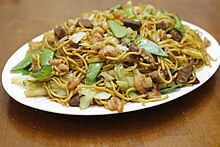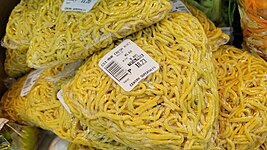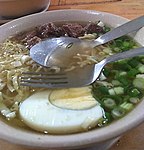Pancit
 Pancit canton, the most popular type of pancit | |
| Alternative names | Pansít |
|---|---|
| Type | Noodle |
| Place of origin | Philippines |
Pancit (Tagalog pronunciation: [panˈsɪt] pan-SIT), also spelled pansít, is a general term referring to various traditional noodle dishes in Filipino cuisine. There are numerous types of pancit, often named based on the noodles used, method of cooking, place of origin, equal and constant diameter or the ingredients.[1][2][3] Most pancit dishes are characteristically served with calamansi, which adds a citrusy flavor profile.[1][4]
Description

The term pancit (or the

Pancit has evolved in Filipino cuisine to combine both Chinese and Spanish techniques, as well as use local ingredients. Pancit is most commonly cooked by sautéing (guisado in
They can also be cooked in a broth or braised. Almost all pancit dishes are also uniquely served with sliced halves of
Pancit dishes are generally named after the types of noodles used. The most commonly used noodles are canton (
- Types of pancit noodles
-
Canton (egg noodles, usually round)
-
Bihon (rice vermicelli)
-
Miki (soft yellowegg noodles, usually squarish)
-
Sotanghon (bean vermicelli)
-
Odong (yellow flour noodles)
-
Misua or miswa (wheat vermicelli)
Pancit is considered both an everyday staple and a
Pancit dishes



- Batchoy – a noodle soup made with pork offal, crushed pork cracklings, chicken stock, beef loin and round noodles. Its origins can be traced to the district of La Paz, Iloilo City in the Philippines
- Maki mi – thick pork tenderloin soup originating from the Chinese-Filipino community of Binondo, Manila.
- Northern Luzon, particularly in the province of Abra. A variant of Pancit Miki, in either soupy or fried version.
- Pancit alanganin – originated from Bocaue, Bulacan. It is made similarly to pancit canton but has a soupy broth with added milk.[6]
- Pancit Bam-I – also known as Pancit Bisaya. A specialty originating in Cebu, with bihon (rice) and canton (wheat) noodles sautéed together.
- Pancit batchoy – Iloilo's stir-fried version of batchoy.
- Pancit Bato – is local to the Bicol Region; especially the town of Bato in Camarines Sur. The noodles are slightly toasted while it's still dry.
- bihon composition depends on someone's personal recipe but usually, Chinese sausage and cabbageare the basic relish.
- Cabagan, Isabelaand nearby towns. Stir-fried and served either dry with separate soup, or "wet" or soup and noodles combined.
- Pancit canton – Filipino adaptation of lo mein and chow mein. Either in instant or stir-fried versions. It is named after the type of noodle used.[9]
- Pancit canton Ilonggo
- Lucena City, Quezon
- bihon.
- Pancit habhab – A Lucban, Quezon specialty. Served in banana leaves, eaten directly without utensils, the name is an onomatopoeia of eating it, like a pig snorts.
- Hi-bol – A noodle soup dish originating from the Ilocos Region that is similar to a mami, but the distinguishing specialty ingredient is tripe from livestock. The name reportedly comes from “high voltage”.
- Naga City, Camarines Sur's version of pancit, in soup or dried form. It consists of noodles garnished by scraped meat from pork or beef's head and other parts, enhanced with a thick deep-brown sauce coming from the brains of a cow or pig. The dish is further flavored with spices (sili and pepper) and served in hot broth. Boiled egg added is optional.
- Pancit lanu – Found only along San Vicente Street in San Pedro, Laguna
- Pancit lomi – Originally from Batangas, pancit lomi is usually sold in eateries across the province. With the mobility of the Filipinos; however, other people got wind of pancit lomi and now different lomihán (eateries serving lomi), panciterias, and carinderias (eateries serving a wider variety of viands with rice) offer it.
- Pancit luglúg or Luglóg – a Kapampangan version of pancit palabok that is essentially the same dish. The only difference is that it uses thicker cornstarch noodles. The name comes from its traditional method of cooking, which uses a bamboo skimmer to submerge the noodles briefly in boiling water.
- Pancit lucban – a type found in Lucban. The noodles are mixed in with generous toppings and ingredients.
- bamboo shoots.[1]
- Pancit mami – round egg noodle soup
- Guinayangan, Quezon
- Pancit miki– round egg noodles, or flat yellow noodles, or dusty white noodles either stir-fried or in soupy version.
- bihon, a hybrid type of stir-fried noodle.
- Pancit Olongapo – pancit miki prepared with sarsa (sauce) made of thickened chicken and pork broth, darkened with a little soy sauce.
- Pancit moròng
- Pancit palabok – uses thinner cornstarch noodles (sometimes substituted with bihon). It is topped with a shrimp-based sauce dyed bright orange with annatto seeds, shrimp, crushed or ground chicharrón, tinapa(smoked fish) flakes, hard-boiled eggs, and green onions.
- Pancit pula – a variation of pancit miki from Batangas City
- Pancit sotanghon – a cellophane noodle soup with a chicken broth base. It may include some kind of meat and vegetable. A typical sotanghon is made with calamansi, sliced straw mushrooms, slivered dark-meat chicken and green onion.
- Pansit sabaw – Pansit miki with soup
- pork-rind cracklingsor chorizo are also added on top. The soup was served separately.
- Pansit sinanta – also from Tuguegarao, consists of flat egg noodles, bihon, clams and chicken, with broth colored with annatto and served with pinakufu, a variant of dango.
- El Filibusterismo.
Non-noodle pancit
Other variants of pancit do not usually use noodles. They include:[1]
- Pancit buko – uniquely uses long coconut strips, instead of noodles.
- mung bean sproutsinstead of noodles.
- Pancit kilawin – a variety of pancit which originated in Rosario, Cavite. In lieu of rice or wheat noodles, shredded unripe papaya fruit is used cooked with vinegar and fish. Usually partnered with dinuguan, a dish made of pig's blood.
- Pancit labong – An early version of pancit Malabon that uses julienned bamboo shoots instead of noodles.[1]
- wonton soupwith wonton wrappers added to the broth, serving as its "noodles".
- Pancit papaya – uses julienned young papaya strips, instead of noodles.
- Gallery of pancit variants
-
"Saucy" pancit canton, a commonbraisedversion
-
Chicken sotanghon soup
-
Sotanghon guisado with calamansi
-
Pancit habhab
-
Pancit lomi
-
Pancit Molo, which uses wontons instead of noodles
Instant pancit
Commercial
See also
References
- ^ .
- ^ ISBN 978-0-19-104072-6.
- ^ a b c "The History of Pancit: The Beginnings and Becomings of this "Long Life" Noodle". Pepper.ph. Retrieved July 9, 2021.
- ^ a b Tee, Sharwin. "12 Best and Unique Pancit Noodle Dishes in the Philippines". Guide to the Philippines. Retrieved July 9, 2021.
- ^ a b Lumen, Nancy Reyes (January 2, 2005). "Republic of Pancit". Philippine Center for Investigative Journalism. Archived from the original on October 28, 2009. Retrieved October 27, 2009.
- ^ a b "Recipe: Pansit Alanganin". ABS-CBN News. October 6, 2014. Retrieved August 7, 2021.
- ^ Mendiola, Idge (May 6, 2018). "Here's how to Tell the Difference Among Those Asian Noodles at the Supermarket". Yummy.ph. Retrieved July 9, 2021.
- ^ a b Ramos, Ige (November 18, 2013). "Kumain at tumulong". Bandera. Retrieved January 18, 2022.
- ^ "Pancit Canton Recipe". Pinoy Recipe at Iba Pa. May 31, 2021.
- ^ Kare, Sarita (April 8, 2008). "Albay Folk Promote Seaweed 'Pansit'". ABS-CBN News. Retrieved September 1, 2021.
- ^ "Pancit Lomi Recipe (Lomi Batangas)". Recipe ni Juan. July 25, 2022.
External links















